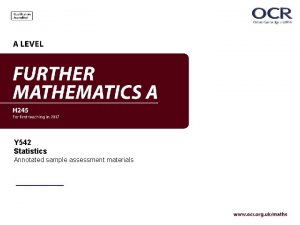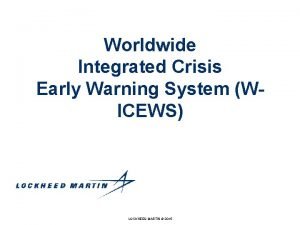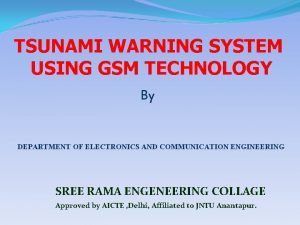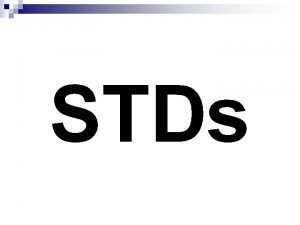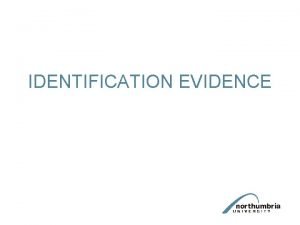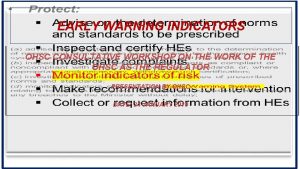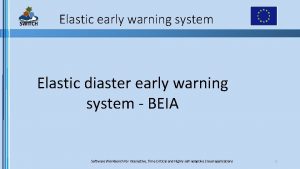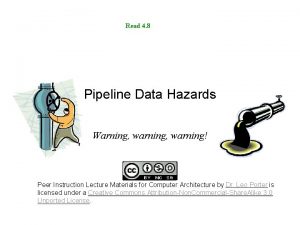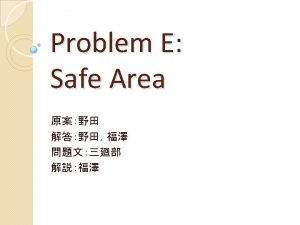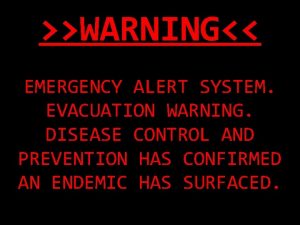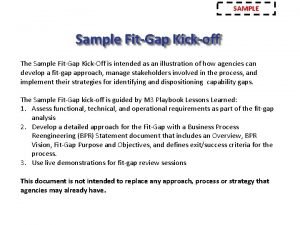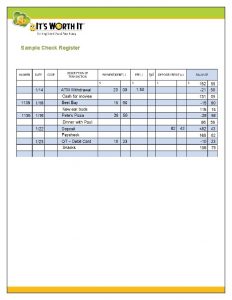WARNING Sample chapter Materials in this sample chapter



![Signed/Unsigned integer – Cont’d Low level machine code 0117136 E mov dword ptr [a], Signed/Unsigned integer – Cont’d Low level machine code 0117136 E mov dword ptr [a],](https://slidetodoc.com/presentation_image/51e74edee934cf559fc3b1613ebcbba3/image-4.jpg)
![Signed/Unsigned integer – Cont’d Low level machine code 0117136 E mov dword ptr [a], Signed/Unsigned integer – Cont’d Low level machine code 0117136 E mov dword ptr [a],](https://slidetodoc.com/presentation_image/51e74edee934cf559fc3b1613ebcbba3/image-5.jpg)


![Signedness issue example #include <stdio. h> int main(int argc, char* argv[]) { if (argc Signedness issue example #include <stdio. h> int main(int argc, char* argv[]) { if (argc](https://slidetodoc.com/presentation_image/51e74edee934cf559fc3b1613ebcbba3/image-8.jpg)

![Signedness issue example OK OK Buggy! unsigned int i = atoi(argv[1]); Unsafe cmp jbe Signedness issue example OK OK Buggy! unsigned int i = atoi(argv[1]); Unsafe cmp jbe](https://slidetodoc.com/presentation_image/51e74edee934cf559fc3b1613ebcbba3/image-10.jpg)












![* CVE-2011 -2110 – Cont’d - - When we crash at: mov eax, [ecx+eax*4], * CVE-2011 -2110 – Cont’d - - When we crash at: mov eax, [ecx+eax*4],](https://slidetodoc.com/presentation_image/51e74edee934cf559fc3b1613ebcbba3/image-23.jpg)






- Slides: 29


WARNING! Sample chapter - Materials in this sample chapter is selected from chapter 4: Integer issue to anything - The materials will be covered in more detail in it’s own chapter - We are going to exploit an integer overflow (CVE-2011 -2110 ) - I hope you will enjoy it!

Signed/Unsigned integer - In c/c++ language integer declaration are signed by default: short, int, long, … - To declare unsigned integer: unsigned prefix - Signed integer can store any integer (-x, +x) - Unsigned integer can store 0 and postivie values (0, +x) unsigned int a = 10; if( a > 5) { //do something char * x = 0; } int b = -2; if( b > 5) { //do something char * x = 0; }
![SignedUnsigned integer Contd Low level machine code 0117136 E mov dword ptr a Signed/Unsigned integer – Cont’d Low level machine code 0117136 E mov dword ptr [a],](https://slidetodoc.com/presentation_image/51e74edee934cf559fc3b1613ebcbba3/image-4.jpg)
Signed/Unsigned integer – Cont’d Low level machine code 0117136 E mov dword ptr [a], 0 Ah if( a > 5) 01171375 cmp dword ptr [a], 5 01171379 jbe main+32 h (1171382 h) { //do something char * x = 0; 0117137 B mov dword ptr [x], 0 } int b = -2; 01171382 mov dword ptr [b], 0 FFFFFFFEh if( b > 5) 01171389 cmp dword ptr [b], 5 0117138 D jle main+46 h (1171396 h) { //do something char * x = 0; 0117138 F mov dword ptr [x], 0 } - Machine code know nothing about unsigned prefix - Compiler generate proper instruction for unsigned/signed values - CPU assign/check different flags for different instructions - Example: JBE v. s JLE JBE: jump if (CF=1 or ZF=1) JLE: jump if (SF<>OF or ZF=1)
![SignedUnsigned integer Contd Low level machine code 0117136 E mov dword ptr a Signed/Unsigned integer – Cont’d Low level machine code 0117136 E mov dword ptr [a],](https://slidetodoc.com/presentation_image/51e74edee934cf559fc3b1613ebcbba3/image-5.jpg)
Signed/Unsigned integer – Cont’d Low level machine code 0117136 E mov dword ptr [a], 0 Ah if( a > 5) 01171375 cmp dword ptr [a], 5 01171379 jbe main+32 h (1171382 h) { //do something char * x = 0; 0117137 B mov dword ptr [x], 0 } int b = -2; 01171382 mov dword ptr [b], 0 FFFFFFFEh if( b > 5) 01171389 cmp dword ptr [b], 5 0117138 D jle main+46 h (1171396 h) { //do something char * x = 0; 0117138 F mov dword ptr [x], 0 } - Some of the instructions: Unsigned DIV MUL SHR JB JA … Signed IDIV IMUL SAR JL JG …

Signed/Unsigned integer – Cont’d As an example a Short integer (16 bit) store the same way in CX register signed or unsigned: CX 0 xfe 12 1111111000010010 Not 0000000111101101 Unsgined 65042 signed -1 ED -493

Integer Overflow - Can be occurred because of: 1. 2. Signedness issue improper or lack of checks - Occurs when a memory or register is able to store larger number value than the programmer expected. - Is a bug not a vulnerability - Is not a memory corruption but can cause memory corruption so vulnerability
![Signedness issue example include stdio h int mainint argc char argv if argc Signedness issue example #include <stdio. h> int main(int argc, char* argv[]) { if (argc](https://slidetodoc.com/presentation_image/51e74edee934cf559fc3b1613ebcbba3/image-8.jpg)
Signedness issue example #include <stdio. h> int main(int argc, char* argv[]) { if (argc != 2) return -1; unsigned int i = atoi(argv[1]); if( i > 100 ) { printf("high temperature"); } else { printf("low temperature"); } return 0; }

Signedness issue example What programmer expected? - The program checks if temperature (integer input) is greater than some value. - Detect high temperature - Turn of the pump or any device Attacker view - There is an improper declaration of temperature variable, So integer signedness issue. - The device can be turned off by freezing the environment: 1. 2. Causing DOS Or maybe Security bypass
![Signedness issue example OK OK Buggy unsigned int i atoiargv1 Unsafe cmp jbe Signedness issue example OK OK Buggy! unsigned int i = atoi(argv[1]); Unsafe cmp jbe](https://slidetodoc.com/presentation_image/51e74edee934cf559fc3b1613ebcbba3/image-10.jpg)
Signedness issue example OK OK Buggy! unsigned int i = atoi(argv[1]); Unsafe cmp jbe dword ptr [i], 64 h main+64 h (9 E 13 F 4 h) Safe cmp jle dword ptr [i], 64 h main+64 h (9 E 13 F 4 h) 009 E 13 D 5 009 E 13 D 9

CVE-2011 -2110 Product: Flash player before 10. 3. 181. 26 Bug class: Array index integer overflow Component: AVM 2 virtual machine

AVM 2 virtual machine - Flash player is a plugin software that can be attacked via browser by convincing victims to malicious link. Action. Script 3 is a high level language embedded as AVM 2 virtual machine in flash player AVM 2 virtual machine interpret bytecodes (delivered by SWF file ) to machine code. So vulnerabilities in verification and processing of bytecodes can be occurred!

AVM 2 virtual machine Hello world AS 3: package { import flash. text. Text. Field; import flash. display. Movie. Clip; public class simple extends Movie. Clip { public function simple() { var avail. Txt: Text. Field = new Text. Field(); add. Child(avail. Txt); avail. Txt. append. Text("hello action script" ); } } } C: flex_sdk_4. 6_2bin>mxmlc simple. as

AVM 2 virtual machine. swf file Swf Header File. Attributes Tag . as source package { import flash. text. Text. Field; import flash. display. Movie. Clip; public class simple extends Movie. Clip { public function simple() { var avail. Txt: Text. Field = new Text. Field(); add. Child(avail. Txt); avail. Txt. append. Text("hello action script" ); } } } X Tag … Tag Mxmlc. exe compiler Browser Flash Player Plugin Do. ABC Tag ABCFile Constants Byte. Codes Other stuffs… End Tag AVM 2 Virtual machine

CVE-2011 -2110 – Cont’d Proof of concept AS 3 Code triggering the vulnerability: package { import flash. display. *; public class flashplayer extends Movie. Clip { public function flashplayer() { crash(1); } public function exploit(. . . args) : void { String(args[0 xf 0000000]); } } }

CVE-2011 -2110 – Cont’d DEMO Crash under the debugger

Array index overflow - Overflowed integer can be an array index Based on the array usage it can also be a critical vulnerability, examples: 1. 2. CVE-2013 -2551 Pwn 2 Own 2013 IE 10 CVE-2011 -2371 Firefox 4. 0. 1 Array. reduce. Right

Array index overflow – Cont’d - Array index overflow demonstration #include <stdio. h> void f 0(char *c){ printf("0%s", c); }; void f 1(char *c){ printf("1%s", c); }; void f 2(char *c){ printf("2%s", c); }; void f 3(char *c){ printf("3%s", c); }; void f 4(char *c){ printf("4%s", c); }; void f 5(char *c){ printf("5%s", c); }; void f 6(char *c){ printf("6%s", c); }; void f 7(char *c){ printf("7%s", c); }; void f 8(char *c){ printf("8%s", c); }; void f 9(char *c){ printf("9%s", c); }; typedef struct Structure 1 { void (*ptr. Functions[10])(char *); char buff[100]; }; void init. Structure(Structure 1 * str 1, char * message) { str 1 ->ptr. Functions[0] = f 0; str 1 ->ptr. Functions[1] = f 1; str 1 ->ptr. Functions[2] = f 2; str 1 ->ptr. Functions[3] = f 3; str 1 ->ptr. Functions[4] = f 4; str 1 ->ptr. Functions[5] = f 5; str 1 ->ptr. Functions[6] = f 6; str 1 ->ptr. Functions[7] = f 7; str 1 ->ptr. Functions[8] = f 8; str 1 ->ptr. Functions[9] = f 9; strcpy(str 1 ->buff, message); } int main(int argc, char* argv[]) { if (argc != 3) return -1; Structure 1 str 1; init. Structure(&str 1, argv[2]); int number = atoi(argv[1]); if ( number < 10) str 1. ptr. Functions[number](str 1. buff); return 0; }

Array index overflow – Cont’d - The program uses index value directly instead of switch case to an array of function pointers Print command number with a message C: >index. Overflow. exe 5 hello 5 hello C: >index. Overflow. exe 7 goodbye 7 goodbye - Check for command number less than 10 But invalid variable type declaration cause signedness issue, So!

Array index overflow – Cont’d

CVE-2011 -2110 – Cont’d DEMO Vulnerability analysis

CVE-2011 -2110 – Cont’d AVM 2 Atom Object data Object - 001 String - 010 Name. Space - 011 Undefined - 100 Boolean - 101 Integer - 110 Double - 111 Type
![CVE2011 2110 Contd When we crash at mov eax ecxeax4 * CVE-2011 -2110 – Cont’d - - When we crash at: mov eax, [ecx+eax*4],](https://slidetodoc.com/presentation_image/51e74edee934cf559fc3b1613ebcbba3/image-23.jpg)
* CVE-2011 -2110 – Cont’d - - When we crash at: mov eax, [ecx+eax*4], eax register is under control and ecx is the pointer to the array ecx is a pointing to offset +0 x 108 of esp register so the array is on the stack memory So we can dereference any offset in the virtual memory with base of current thread stack. 0 X 0000 Current thread Stack ESP ECX [ECX+EAX*4] By changing eax value any offset can be returned. 0 X 7 FFFFFFF

CVE-2011 -2110 Exploitation What we have? - A bug that let us dereference any value from memory as AS 3 atom. - The atom can be manipulated by high level AS 3 code. What we do? - Read some controllable value from memory as atom - Pass it to some other AS 3 function that threat our atom as a fake object. - Fake object has fake vftable, so calling any of it’s virtual functions lead to exploitable condition

CVE-2011 -2110 Exploitation DEMO Derefrencing the meat

CVE-2011 -2110 Exploitation - We have our controllable value on the stack We should find the proper index to dereference it as atom, Solving the equation: ecx - 200 = ecx + eax * 4 -200 = eax * 4 eax = -200 / 4 -> eax = 0 x. FFFFFF 38 / 4 -> eax = 4294967096 / 4 = 1073741774 = 0 x 3 FFFFFCE

CVE-2011 -2110 Exploitation DEMO Gaining EIP

Heap spray exploitation - Demonstrated in the wild mostly in browser exploitation but may be applied in other cases Understanding it is better than doing it by copying and pasting available scripts from other exploits. Restricted to 32 bit environment Easy but heavy

 Creddump
Creddump Cant stop the feeling trolls go noodle
Cant stop the feeling trolls go noodle Household materials harmful and useful
Household materials harmful and useful Man made materials
Man made materials Differentiate adopting materials and adapting materials
Differentiate adopting materials and adapting materials Direct materials budget with multiple materials
Direct materials budget with multiple materials Ocr sample assessment materials
Ocr sample assessment materials Icews
Icews Kfupm graduate
Kfupm graduate Schkin
Schkin Giving warning
Giving warning Alert warning symbols and controls worksheet
Alert warning symbols and controls worksheet Curriculum guide for driver education in virginia module 10
Curriculum guide for driver education in virginia module 10 Conclusion on tsunami
Conclusion on tsunami Controlled access zone vs warning line
Controlled access zone vs warning line Warno example
Warno example Male std warning signs
Male std warning signs Alert warning symbols and controls
Alert warning symbols and controls Forex risk warning
Forex risk warning Dupage county tornado
Dupage county tornado Percentage calculations worksheet
Percentage calculations worksheet Spotoca warning order
Spotoca warning order Warning signs of a seizure
Warning signs of a seizure Warning order example
Warning order example Turnbull guidelines advokate
Turnbull guidelines advokate Recruiting yield pyramid
Recruiting yield pyramid Early warning intervention and monitoring system
Early warning intervention and monitoring system Early warning system in disaster management
Early warning system in disaster management Ohsc early warning system
Ohsc early warning system Ohsc early warning system
Ohsc early warning system






